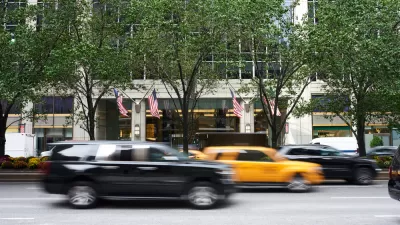As London's next mayoral election draws near, Rowan Moore evaluates the good and the bad in planning, architecture, and design from Mayor Boris Johnson's first four years at the helm.
Purview over the physical shape of the city is one of the few areas that falls within the "relatively limited range of powers" bestowed upon London's mayors. "They oversee the London plan, which guides the future development of the city, and have the power to approve or refuse significant planning applications. They have budgets that can be spent on the city's public spaces."
Judged by these elements, Moore finds a less coherent approach to city building than Johnson's predecessor, Ken Livingstone, who "adopted Richard Rogers's idea of the "compact city", that it was good to densify and intensify the centre of London, rather than let it sprawl horizontally into the green belt."
In the litany of projects and policies credited to Johnson, Moore doesn't seem to find a coherent strategy, or one he's willing to identify as Johnson's own. In his assessment, Moore finds that Johnson's "mayoralty has been more impressive when it comes to things that are barely visible, or about taking stuff away rather than adding it."
Moore concludes: "This, then, is Borisopolis: a combination of show-off whatsits and fairly sensible stuff. When it comes to public space there is not a fundamental difference between Labour and Tory, Livingstone and Johnson. Both think it's a Good Thing and both have an idea of a city that favours pedestrians and cyclists more than it did before. Johnson and his administration do however deserve credit for getting some things done that make London, in a modest way, a better place to live."
FULL STORY: Borisopolis: London under Boris Johnson

Planetizen Federal Action Tracker
A weekly monitor of how Trump’s orders and actions are impacting planners and planning in America.

Map: Where Senate Republicans Want to Sell Your Public Lands
For public land advocates, the Senate Republicans’ proposal to sell millions of acres of public land in the West is “the biggest fight of their careers.”

Restaurant Patios Were a Pandemic Win — Why Were They so Hard to Keep?
Social distancing requirements and changes in travel patterns prompted cities to pilot new uses for street and sidewalk space. Then it got complicated.

Platform Pilsner: Vancouver Transit Agency Releases... a Beer?
TransLink will receive a portion of every sale of the four-pack.

Toronto Weighs Cheaper Transit, Parking Hikes for Major Events
Special event rates would take effect during large festivals, sports games and concerts to ‘discourage driving, manage congestion and free up space for transit.”

Berlin to Consider Car-Free Zone Larger Than Manhattan
The area bound by the 22-mile Ringbahn would still allow 12 uses of a private automobile per year per person, and several other exemptions.
Urban Design for Planners 1: Software Tools
This six-course series explores essential urban design concepts using open source software and equips planners with the tools they need to participate fully in the urban design process.
Planning for Universal Design
Learn the tools for implementing Universal Design in planning regulations.
Heyer Gruel & Associates PA
JM Goldson LLC
Custer County Colorado
City of Camden Redevelopment Agency
City of Astoria
Transportation Research & Education Center (TREC) at Portland State University
Camden Redevelopment Agency
City of Claremont
Municipality of Princeton (NJ)




























